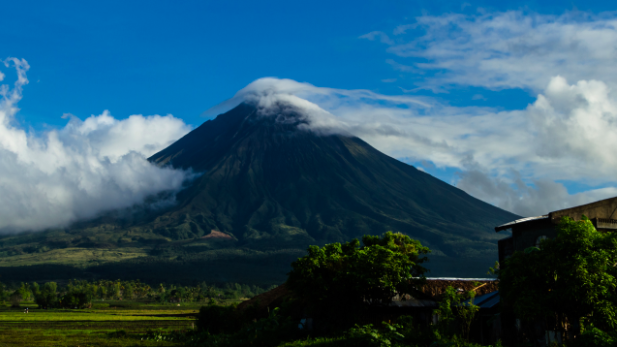TABACO CITY— Lami Rivera, 34, and her husband spent Saturday night, April 1, at the Holy Rosary Mountain Chapel in this city, seeking divine intervention and asking God to help them conceive a child.
“We’re holding out hope that, through a miracle, we can still have a baby,” Rivera, a resident of Polangui town in Albay province, who had been married for almost 10 years, told the Inquirer.
When they visited a faith healer in Ligao City, they were advised to stay for at least a night at the chapel and pray a novena in front of the image of the Holy Family to grant them a child.
“Sometimes I pray for impossible things, and they happen. Everyone fears the Mayon Volcano eruption, but with God’s protection, no debris or ashes reached us. That’s one big miracle I witnessed here,” said Zaldy Perol, 49, the administrator of the mountain chapel in Barangay Buang.
The chapel is located at the Mayon Skyline View Deck, a nature park and one of Albay’s favorite tourist destinations because of its scenic view of the volcano’s peak, the Pacific Ocean, and cooler temperature as it is 2,700 feet above sea level and inside the three-kilometer radius of the volcano.
It could be accessed through a jeepney from Ligao going to Sabluyon Road to the upland village.
There is no public transportation available to go to the summit.
Calling
When Nenita Tan, a resident of Ilocos Sur province, was roaming the area in the 1980s, using her telescope, she saw an image of a woman in a white dress on the mountain, which she believed to be the Our Lady of the Most Holy Rosary.
From then on, she continued her devotion through the Way of the Cross from the foot of the mountain every first Friday of the month, Perol said.
On Oct. 7, 1987, they built a “kubol,” or shed, made of coconut lumber, iron sheets as roof, and light materials that served as a small chapel.
When Tan died in 2012, the management of the chapel was turned over to a group of devotees called the Holy Rosary Mountain Chapel Community.
Serving the community for almost 23 years was Perol’s way of accepting his calling and living his childhood dream of becoming a priest.
He enrolled in the seminary in 1992 but was not able to pursue it due to financial problems.
“Even if I wasn’t able to finish [schooling in] the seminary, at least here I can still serve God and the people who visit us,” he said.
He lives in a small room near the chapel, but his parents reside in Manito town in Albay.
A priest from San Antonio Parish officiates mass at the chapel every first Saturday of the month.
Devotees
More than 10,000 pilgrims would participate in the annual “alay lakad” or religious pilgrimage every Good Friday, which starts from the first Station of the Cross near the junction road and ends at the chapel, about 9.5 kilometers long.
It could take two to three hours to complete the way of the cross and vigil along the curved and steep road.
Myrna Bon, 59, made sure her family would not miss the Alay Lakad as their form of sacrifice and giving thanks to God for providing for their needs.
“We always pray for sustenance and strength, especially for my child with lung disease,” she said.
Her family has lived near the foot of the mountain since 1987, and they would trek each day to reach the top to sell bonsai to tourists, which serves as their main livelihood.
The big gathering of Catholic devotees was stopped in 2018 after the hazardous eruption of the volcano, and was continuously halted during the pandemic.
With travel restrictions eased, Perol said the devotees slowly returned for religious activities.
Since the start of the Lenten season this year, about 20 groups with around 1,000 devotees have had their vigils and visits at the chapel.
Perol said some were from Pangasinan, Davao City, and other provinces.
Risks
On March 16, the Philippine Institute of Volcanology and Seismology placed the volcano on alert level 1, or low level of unrest, but the agency still warned the public to avoid entering the six-kilometer permanent danger zone due to a possible eruption.
Hugo Buen, chief of the Tabaco City Disaster Risk Reduction and Management Office, said they only allowed visitors who had their own vehicles to easily escape in case of emergencies and volcanic eruptions.
“We do not allow those who just walk upwards because, in the event of an eruption, we cannot rescue a large number of people. Those who use vehicles are allowed, because of course, it is still a tourist destination,” Buen said in a phone interview on April 2.
Buen said Visita Iglesia (the Roman Catholic tradition of visiting several churches on Holy Week) would also be allowed for visitors with their own vehicles.
Eusebio Lorico, chairman of Barangay Buang, said their watchmen would be deployed along the junction at the foot of the Mayon Skyline to prevent devotees from doing the way of the cross by foot.
“Since we do not know when it [Mayon Volcano] would erupt, those with service vehicles who really wanted to go up were advised to become alert,” Lorico said in a separate phone interview on April 2.
